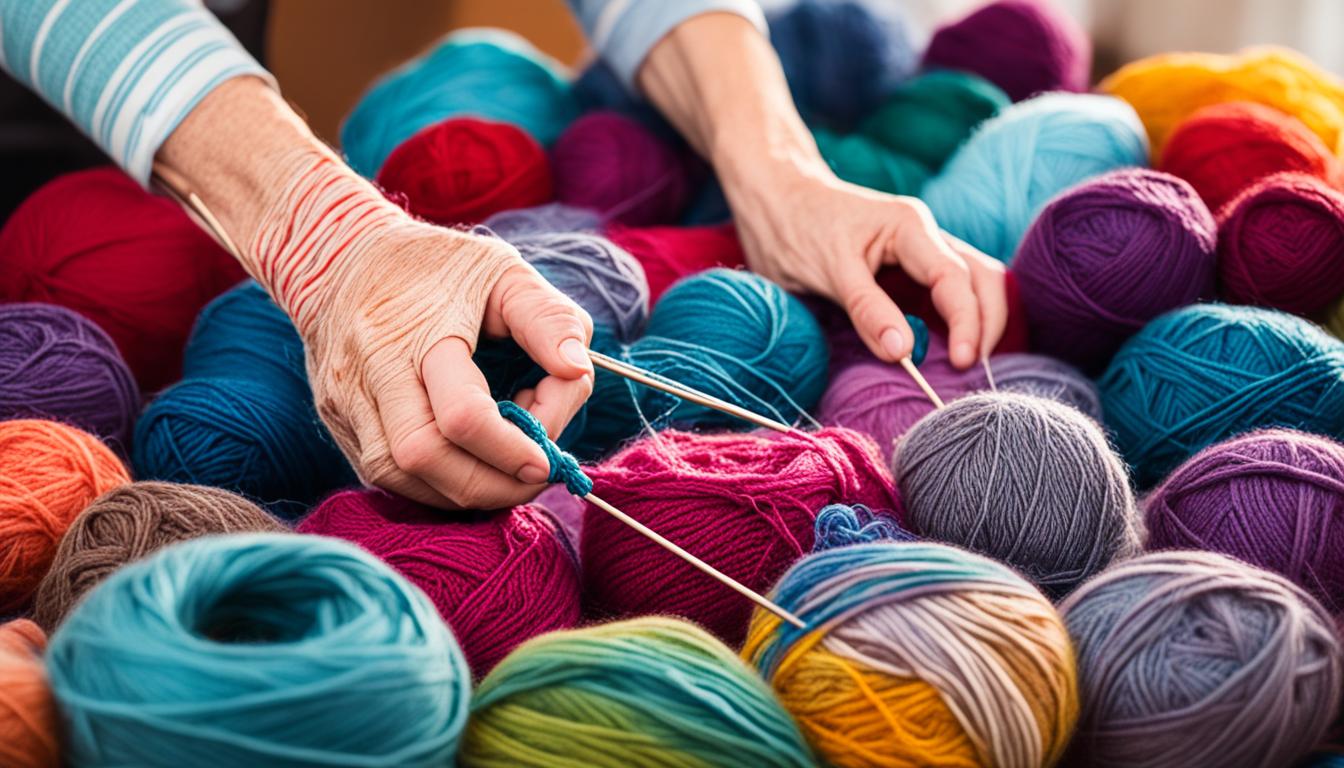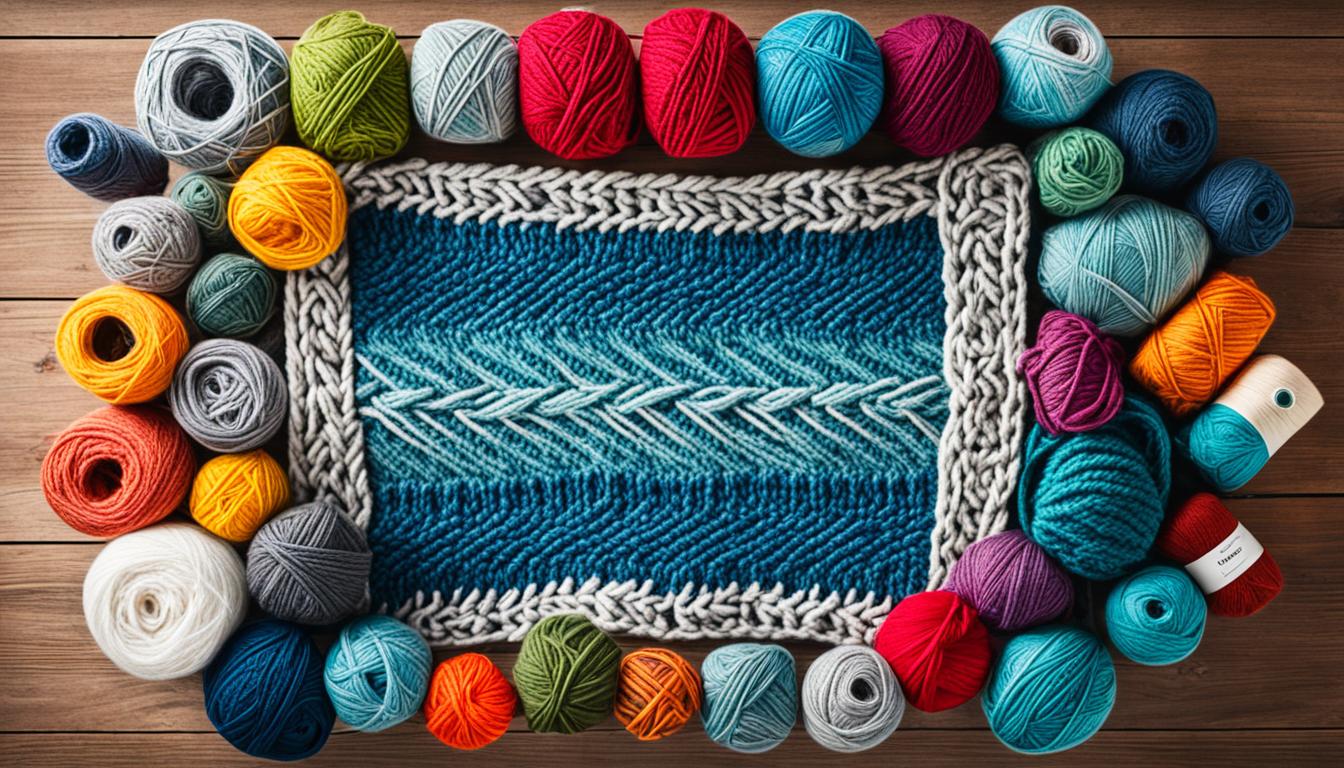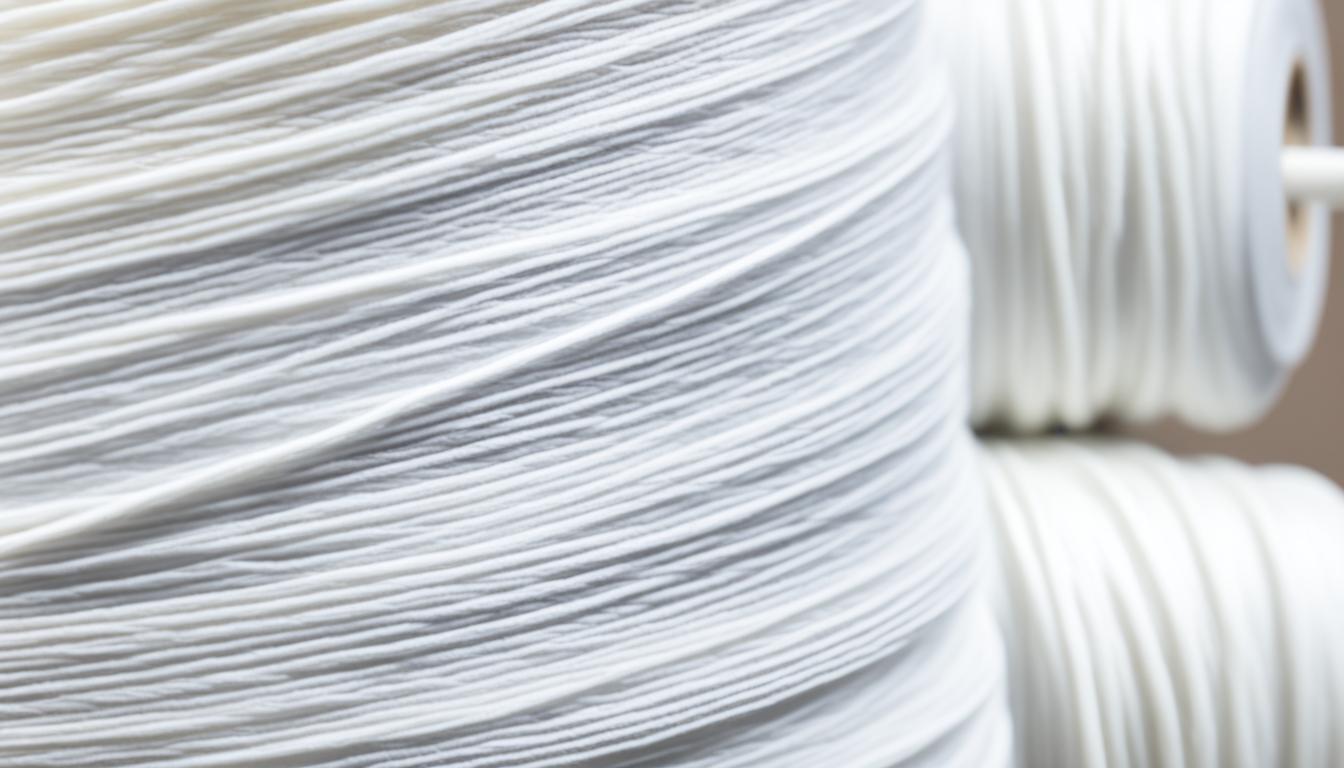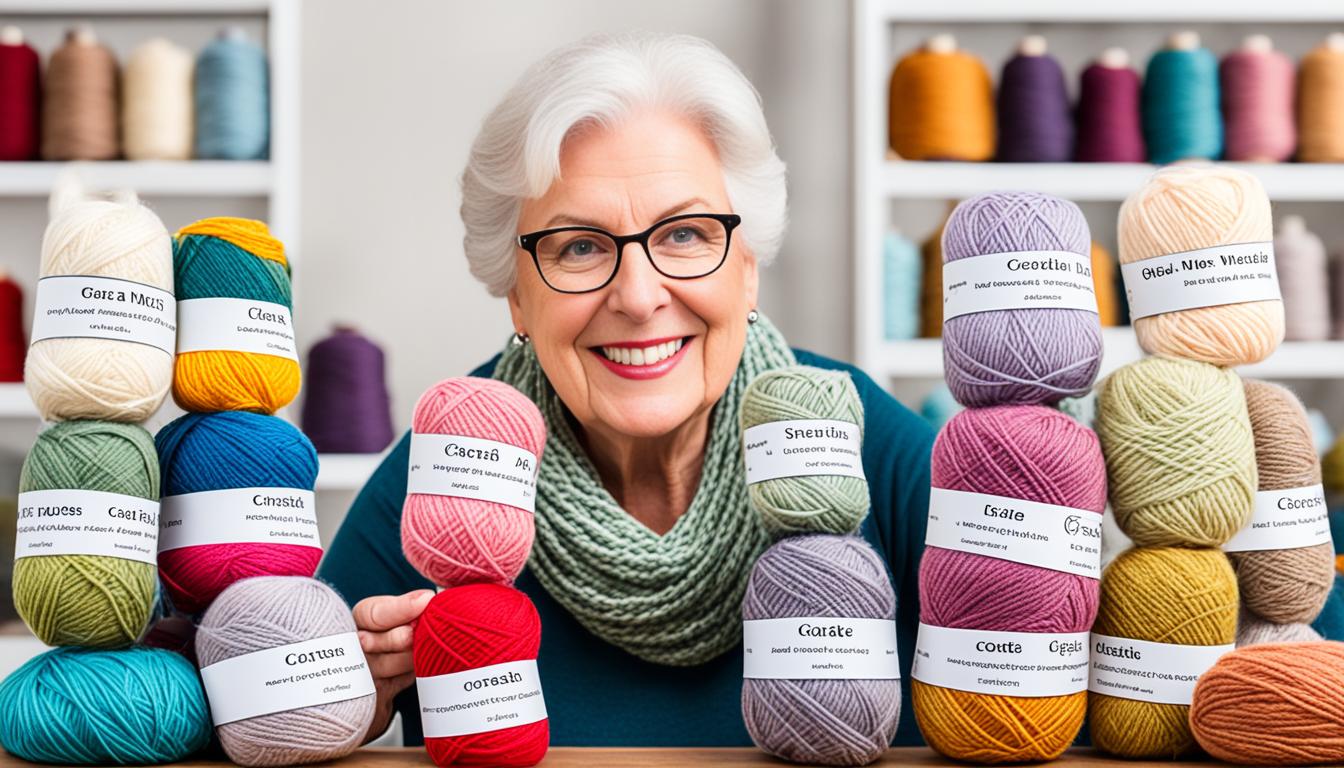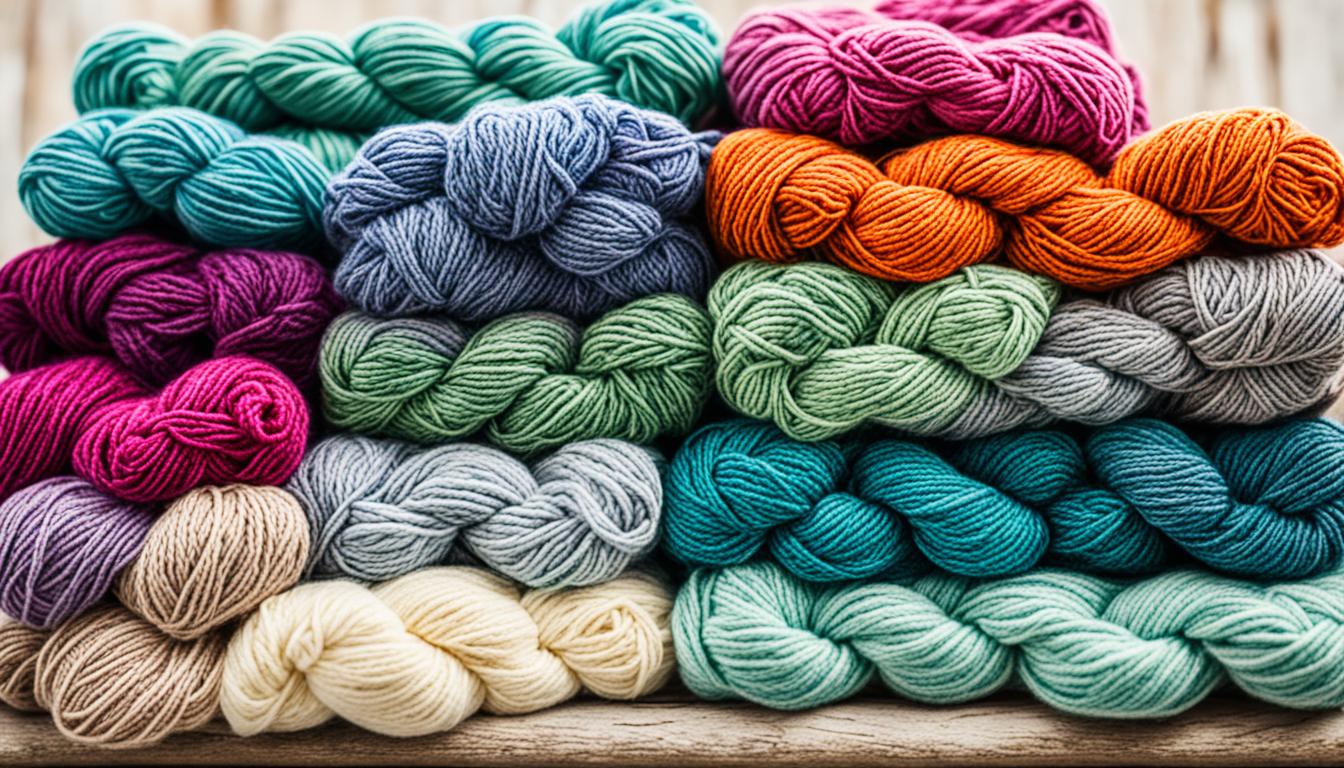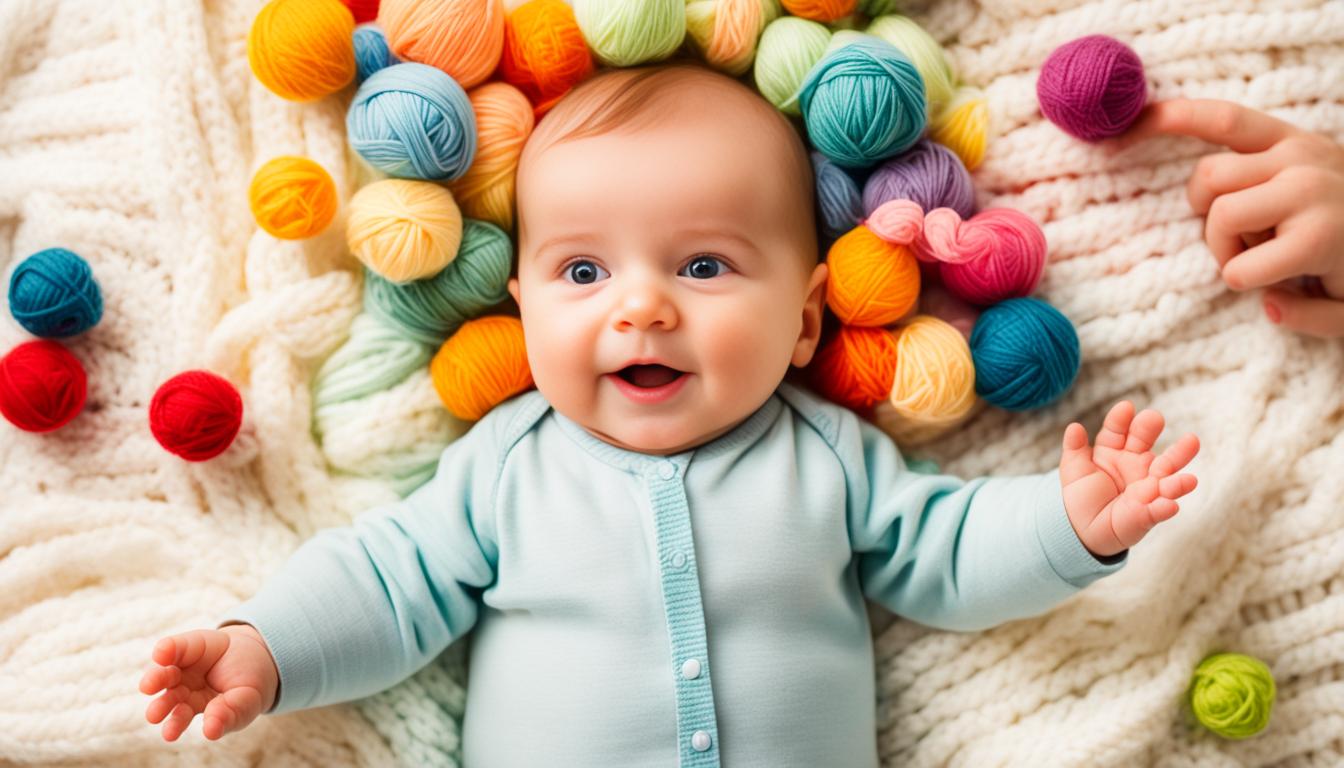Can a yarn store be more than just a place to purchase yarn and supplies? Can it provide comfort, peace, and restoration? We encourage you to discover the healing power of yarn crafts and uncover the therapeutic advantages they can bring to your life. In this article, we will explore the realm of yarn therapy and how yarn stores can evolve into havens for emotional healing and wellness.
Key Takeaways:
- Engaging in yarn crafts like knitting and crocheting can have mental health benefits, reducing stress, anxiety, and depression.
- Yarn stores can create a soothing atmosphere through careful design and ambiance.
- Yarn crafts can serve as a form of self-care, promoting relaxation and emotional healing.
- The sense of community in yarn stores can provide support and a feeling of belonging.
- Yarn stores can inspire creativity and offer a wide range of projects to explore.
The Mental Health Benefits of Knitting and Crocheting
Knitting and crocheting offer more than just a creative outlet; they also provide numerous mental health benefits. Engaging in these yarn crafts can have a therapeutic effect on our well-being, promoting relaxation, reducing stress levels, and boosting our mood.
When we immerse ourselves in knitting or crocheting, we enter a state of calm and focus. The repetitive motion of our hands and the rhythmic patterns of the stitches become meditative, allowing our minds to relax and find peace in the present moment. This meditative quality of yarn crafts can be incredibly soothing, helping us release tension and quiet the noise in our minds.
Furthermore, knitting and crocheting can serve as a form of mindfulness practice. As we work with the yarn and needles or hooks, we become fully present in the process. We pay attention to each stitch, each loop, and each movement, allowing ourselves to let go of external distractions and thoughts. This mindfulness aspect of yarn crafts enables us to reconnect with ourselves and find a sense of inner calm and clarity.
“Knitting and crocheting have become my go-to activities whenever I need a moment of peace. The repetitive motion of the needles or hook helps quiet my mind and allows me to focus on the present. It’s like my own form of therapy.”
Engaging in knitting or crocheting also has an instant gratification aspect to it. Seeing a project take shape gives us a sense of accomplishment and boosts our self-esteem. This tangible progress can be especially beneficial for those struggling with stress, anxiety, or depression, as it provides a sense of control and achievement.
Ultimately, the mental health benefits of knitting and crocheting extend beyond the finished project. The process itself offers an opportunity for self-expression, relaxation, and emotional healing. By incorporating these yarn crafts into our daily lives, we can tap into the therapeutic power of creativity and find serenity in every stitch.
Knitting and Crocheting for Mental Well-being: A Comparative Analysis
| Benefits | Knitting | Crocheting |
|---|---|---|
| Stress reduction | ✓ | ✓ |
| Promotes relaxation | ✓ | ✓ |
| Boosts mood | ✓ | ✓ |
| Meditative quality | ✓ | ✗ |
| Mindfulness practice | ✓ | ✓ |
| Instant gratification | ✓ | ✓ |
Creating a Healing Atmosphere in a Yarn Shop
Yarn shops can truly be sanctuaries, providing a peaceful and healing atmosphere for individuals seeking solace and comfort. The carefully curated layout and aesthetics of the store play a crucial role in creating a calming space that feels like a nurturing haven. We believe that the ambiance within a yarn shop is just as important as the products it offers, and we strive to create an environment that promotes relaxation and emotional well-being.
Soft lighting gently illuminates the yarn displays, creating a warm and inviting glow that instantly puts visitors at ease. Comfortable seating areas are thoughtfully arranged throughout the shop, providing cozy nooks for customers to settle into while exploring the world of yarn. As visitors browse the exquisite selection of yarn, the soothing melodies of soft, instrumental music fill the air, creating a serene backdrop for their experience.
Our store is adorned with elements that evoke a sense of coziness and tranquility. Warm, earthy colors and natural textures embrace customers as they step through the door, instantly enveloping them in a feeling of serenity. Soft rugs, plush cushions, and rustic wood accents further enhance the inviting atmosphere, creating a space where worries can melt away, and creativity can flourish.
We firmly believe that a healing atmosphere goes beyond the visual and auditory elements of a space. It encompasses the gentle interactions and heartfelt conversations between our staff and customers. Our knowledgeable and passionate team members are always ready to offer guidance, recommendations, and words of encouragement. We strive to create a supportive environment where individuals feel seen, heard, and valued.
“Stepping into this yarn shop feels like stepping into a sanctuary. The moment I walk through the door, I can feel the stress of the day begin to melt away. The inviting ambiance and cozy seating areas make me want to stay for hours, surrounded by the softest yarn and the company of fellow crafters. It truly is a healing space.”
At our yarn shop, we understand that healing comes in many forms, and we are honored to provide a nurturing space where individuals can embark on their unique journey of emotional well-being. We invite you to visit our store, immerse yourself in the healing power of yarn, and discover the serenity that awaits you.
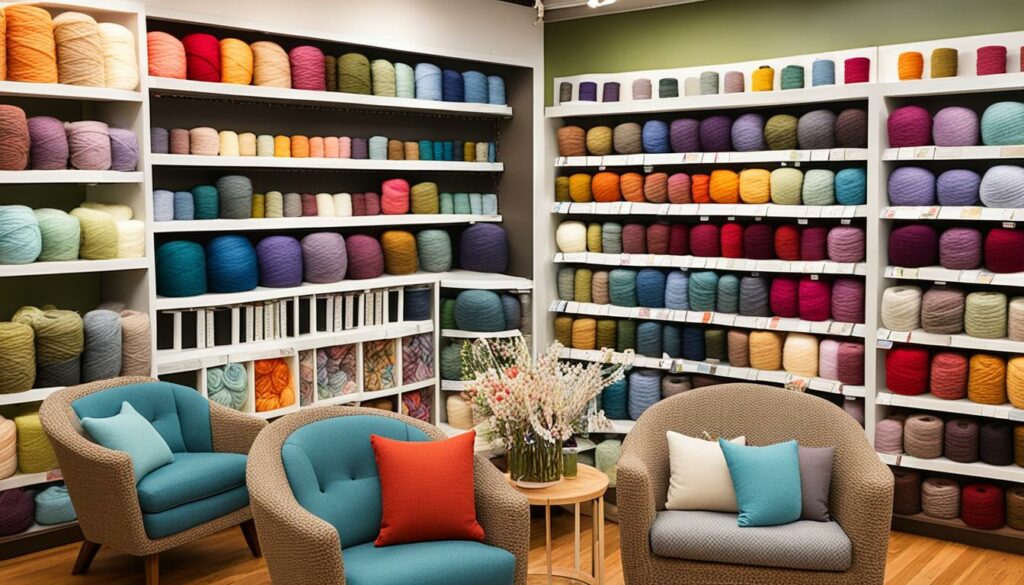
Stay tuned for the next section, where we will explore the therapeutic benefits of yarn crafts and delve into the transformative power of yarn therapy.
Yarn Therapy: Finding Serenity in Yarn Crafts
Yarn therapy, also known as knitting therapy or crochet therapy, offers a path to serenity and emotional healing through the soothing practice of yarn crafts. The repetitive motions of knitting or crocheting have a calming effect on the mind and body, similar to the tranquility found in meditation. By engaging in these activities, individuals can reduce stress, alleviate anxiety, and experience a profound sense of accomplishment.
Many people turn to knitting or crocheting as a form of stress relief. The rhythmic motion of knitting needles or crochet hooks moving through the yarn becomes a meditative practice that redirects their focus and quiets the mind. As the hands create intricate stitches and patterns, the mind finds solace in the simplicity of the task at hand. This rhythmic dance with yarn can bring about a state of tranquility and mindfulness, allowing individuals to experience a respite from the pressures of daily life.
“Engaging in yarn crafts provides a therapeutic escape for me. When I knit, I feel a sense of calm wash over me, and all the worries and stress melt away. It’s like a form of meditation that I can hold in my hands and create something beautiful at the same time.” – Emily, avid knitter
Knitting and crocheting allow individuals to channel their energy and emotions into a productive and creative outlet. The act of transforming a simple ball of yarn into a tangible and functional item brings a deep sense of satisfaction and accomplishment. This feeling of achievement can boost self-esteem and foster a positive mindset.
Moreover, yarn therapy offers a way to cope with challenging emotions and find respite from the demands of everyday life. The repetitive nature of the craft provides a soothing rhythm that can help individuals find inner peace and stability. Engaging in yarn crafts activates the “relaxation response” in the body, leading to decreased heart rate, reduced muscle tension, and an overall sense of well-being.
The Healing Power of Yarn Crafts
The healing power of yarn crafts extends beyond the physical act of knitting or crocheting. The process of selecting colors, textures, and patterns allows for self-expression and creativity, offering a therapeutic escape from daily stressors. Choosing a vibrant color palette or experimenting with intricate stitches can awaken the spirit and kindle a sense of joy and inspiration.
Moreover, yarn crafts offer individuals a tangible representation of their progress and growth. With each stitch and project completed, one’s confidence and self-belief flourish. The act of creating something beautiful and useful with one’s own hands instills feelings of empowerment and resilience.
In a world that often feels fast-paced and chaotic, yarn therapy provides a sanctuary for individuals to slow down, reconnect with their inner selves, and find peace in the present moment. The therapeutic benefits of yarn crafts extend beyond the act of crafting; they weave a tapestry of emotional healing and well-being.
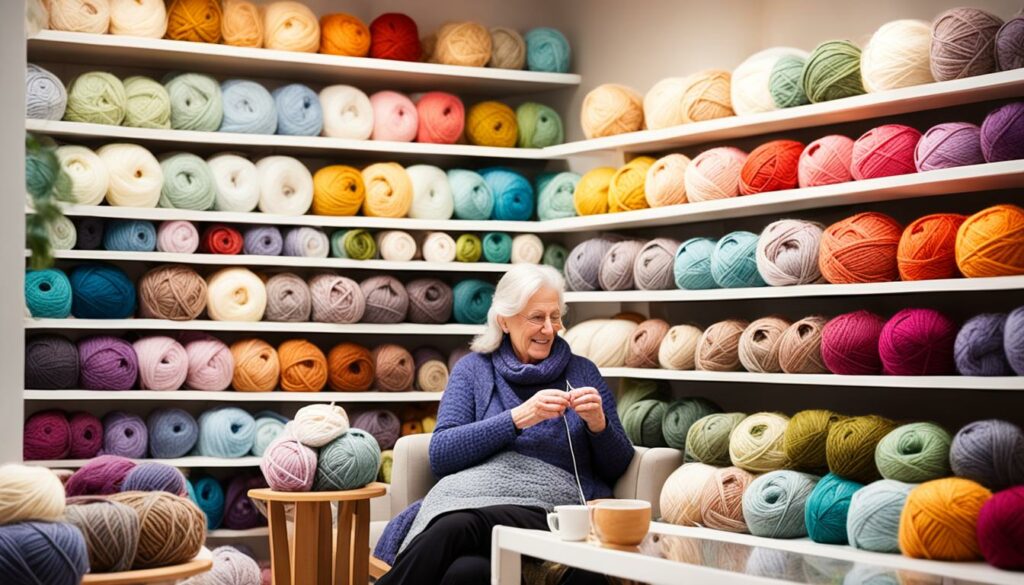
The Role of Community in Yarn Stores
At our yarn store, we understand the importance of building a strong and supportive yarn store community. We believe that connecting with others who share a passion for yarn crafts can have a profound impact on our well-being. That’s why we strive to create an environment that fosters relationships, support, and a sense of belonging.
One of the ways we build community is through knitting and crocheting classes. Our store offers a variety of classes for all skill levels, from beginners to advanced crafters. These classes not only provide an opportunity to learn new skills but also serve as a gathering place for like-minded individuals. Sharing the joy of creating with yarn while learning alongside others creates a sense of camaraderie and support.
Workshops are another way we bring our community together. Our workshops focus on specific techniques, projects, or styles, allowing participants to expand their knowledge and explore new possibilities. These workshops not only provide valuable learning experiences but also foster connections among participants who often find inspiration and encouragement from one another.
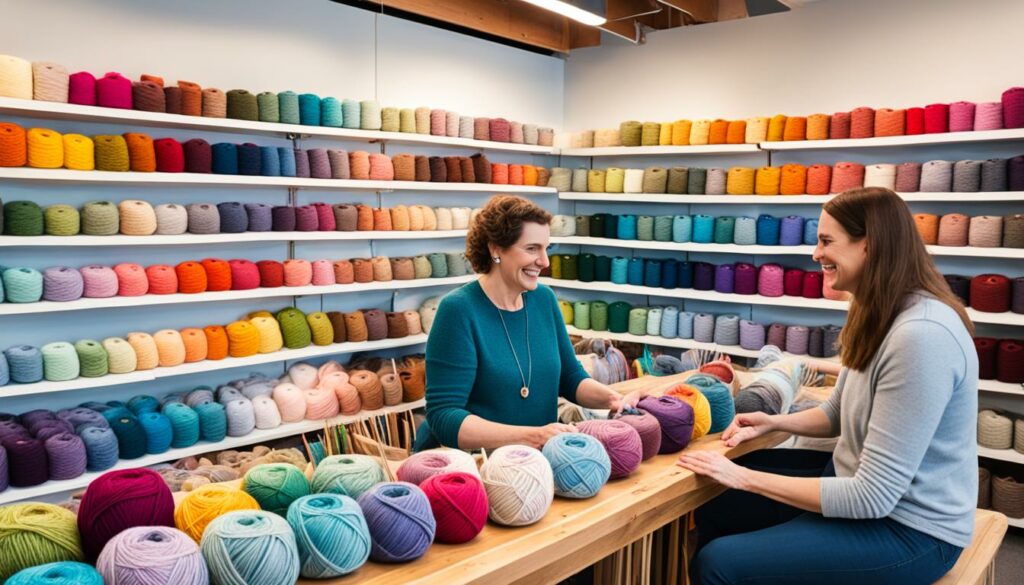
Our yarn store also hosts social gatherings, where individuals can come together and simply enjoy each other’s company. These gatherings provide a space for crafters to share their current projects, seek advice, or simply chat about their love for yarn. The supportive environment allows for open conversation, where individuals can offer support, inspiration, and guidance.
Being part of a yarn store community offers more than just the opportunity to connect with others. It provides a sense of support during challenging times, a place to celebrate accomplishments, and a network of individuals who share a common passion. Through shared experiences and the power of yarn, our community contributes to emotional healing, personal growth, and well-being.
Testimonials from Our Yarn Store Community:
“Being part of this yarn store community has brought so much joy into my life. I’ve made lifelong friends and found a support system that understands and appreciates my love for yarn crafts. It’s a place where I feel truly accepted and supported.”
“The knitting classes at this yarn store have not only taught me new skills but have also provided a sense of purpose and belonging. I’ve grown as a crafter and as an individual, all thanks to the wonderful community here.”
“Attending the workshops at this yarn store has sparked my creativity and allowed me to discover new techniques. The connections I’ve made with fellow crafters have been invaluable. We inspire and support each other in our crafting journeys.”
“I always look forward to the social gatherings at this yarn store. It’s a time to unwind, connect with others, and share our love for yarn. The community here has become my extended family, and I’m grateful for the friendships I’ve made.”
Join our vibrant yarn store community and experience the support, inspiration, and connection that come with being part of something truly special. Discover the healing power of a community that shares your passion for yarn crafts, where you can grow, create, and find solace in the company of others.
| Benefits of Our Yarn Store Community | Why Join Our Community? |
|---|---|
| Opportunity to learn new skills | Experience a sense of belonging |
| Supportive environment for crafting | Connect with like-minded individuals |
| Inspiration and encouragement | Build lifelong friendships |
| Share ideas and projects | Find solace and emotional healing |
Yarn Crafts as a Form of Self-Care
Engaging in yarn crafts can be a powerful form of self-care. Taking time for ourselves to immerse in the world of knitting or crocheting allows for relaxation, creative expression, and emotional healing. The rhythmic motions of working with yarn can be soothing to the mind and body, providing a sense of calm in the midst of a busy day.
When we engage in yarn crafts, we enter a state of flow, fully absorbed in the present moment. The repetitive nature of knitting or crocheting can help quiet the mind and alleviate stress. We can focus on the gentle movement of our hands and the transformation of yarn into something beautiful. It is an opportunity to slow down, breathe, and find a sense of peace.
Crafting with yarn also offers a unique form of creative expression. Through choosing colors, textures, and patterns, we can channel our emotions and create pieces that reflect our individuality. The act of creating something with our own hands provides a sense of accomplishment and control, which is particularly valuable when we are facing challenging emotions.
Incorporating yarn crafts into our self-care routine allows us to prioritize our well-being and mental health. Whether we dedicate a few minutes or a few hours to knitting or crocheting, it is an act of self-nurturing. We gift ourselves the time and space to do something we enjoy, to explore our creativity, and to let go of the stresses of daily life.
By embracing yarn crafts as a form of self-care, we not only create beautiful pieces but also nurture our own well-being. It is a gentle reminder to prioritize ourselves, to listen to our needs, and to find solace and healing in the simple act of crafting. Self-care through yarn crafts is a way to honor ourselves and cultivate emotional well-being.
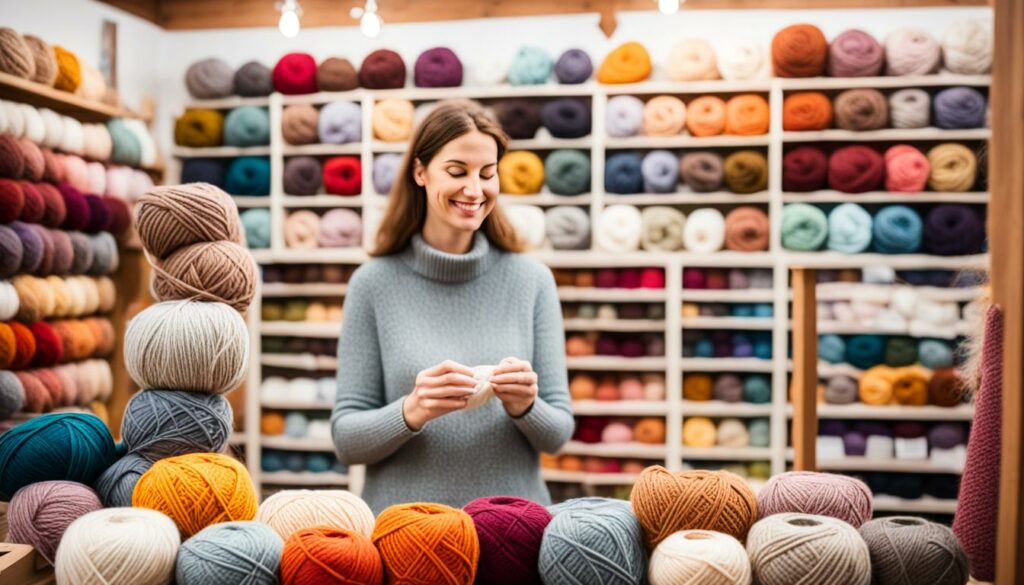
Yarn Store Workshops and Classes
At our yarn store, we understand the value of continuous learning and self-improvement. That’s why we offer a wide range of workshops and classes for individuals interested in learning new yarn crafts or expanding their skills. Our workshops provide a supportive and educational environment where you can engage in hands-on learning, connect with other yarn enthusiasts, and take your crafting journey to the next level.
Whether you’re a beginner looking to try your hand at knitting or an experienced crocheter wanting to explore advanced techniques, our workshops cater to all skill levels. Our knowledgeable instructors will guide you through each step of the process, ensuring that you gain the necessary skills and confidence to create stunning yarn projects.
Discover the joy of learning new yarn crafts and embark on a creative adventure with us. Our workshop offerings include:
- An introduction to knitting
- Crochet basics and beyond
- Advanced knitting techniques
- Specialty yarn crafts
- Amigurumi and toy making
- Colorwork and Fair Isle knitting
In addition to workshops, we also offer regular classes that focus on specific aspects of yarn crafts. These classes provide an opportunity to dive deeper into a particular skill or project, allowing you to refine your techniques and expand your creative repertoire. Our classes cover a wide range of topics, such as:
- Creating intricate lace patterns
- Designing your own patterns
- Exploring different yarn dyeing techniques
- Embroidery and embellishments
- Pattern reading and modifications
Participating in our workshops and classes not only enhances your crafting skills but also fosters a sense of community and camaraderie. You’ll have the opportunity to connect with fellow yarn enthusiasts, share ideas, and inspire one another on your creative journeys. Together, we can explore the endless possibilities of yarn crafts and create beautiful, meaningful pieces.
“The workshops at this yarn store have transformed my crafting experience. Not only have I learned new skills, but I’ve also formed lifelong friendships with fellow workshop participants. The sense of support and encouragement is truly remarkable.” – Lisa, workshop participant
Join us at our yarn store and embark on a transformative learning experience. Don’t miss out on the opportunity to expand your skills, ignite your creativity, and connect with a vibrant community of yarn enthusiasts.
| Benefits of Our Workshops and Classes | Why Choose Us |
|---|---|
| Hands-on learning experience | Expert instructors with years of experience |
| Opportunity to connect with fellow yarn enthusiasts | Wide range of workshop options for all skill levels |
| Learn new techniques and expand your creative repertoire | Supportive and nurturing learning environment |
| Create beautiful, meaningful yarn projects | Access to a vibrant and inclusive community |
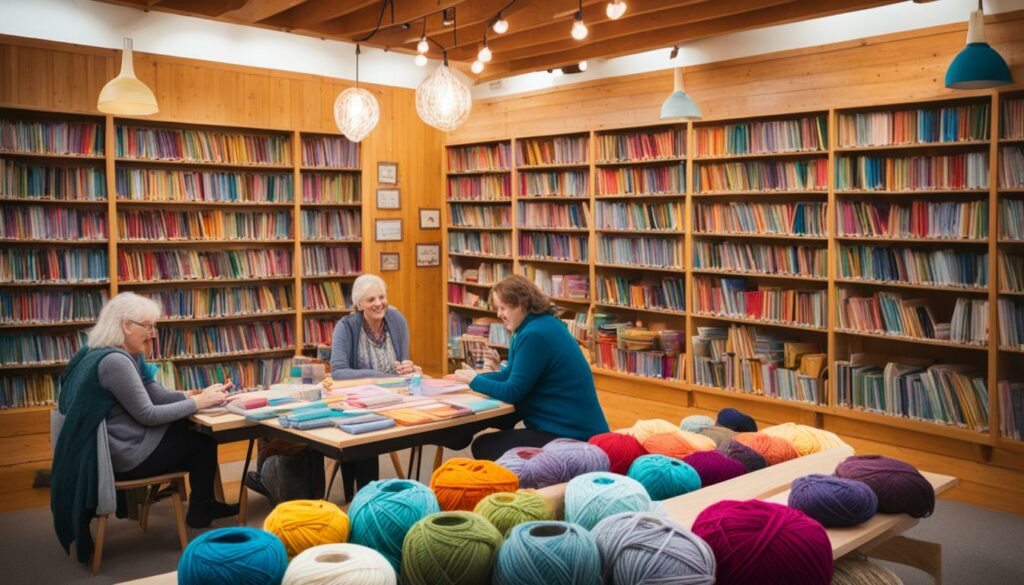
The Artistic Expression of Yarn Crafts
Yarn crafts, such as knitting and crocheting, offer a unique opportunity for artistic expression and creativity. With just a ball of yarn and a set of needles or a crochet hook, one can transform simple strands into intricate patterns, unique designs, and beautiful creations that showcase their artistic abilities.
Engaging in these crafts goes beyond the practicality of creating warm scarves or cozy blankets. It becomes a means of self-expression and a platform to let our creative instincts soar.
When working with yarn, we have the freedom to choose from a diverse palette of colors, textures, and materials. The process of selecting the perfect combination of hues, experimenting with various stitches and patterns, and envisioning the final result allows us to tap into our artistic side and bring our imagination to life.
Whether knitting a delicate lace shawl or crocheting a whimsical amigurumi toy, each stitch becomes an individual brushstroke in our artistic expression. We have the power to infuse our personality, emotions, and experiences into our creations, making them truly one-of-a-kind.
Moreover, the act of creating with yarn can be both therapeutic and empowering. As we immerse ourselves in the rhythmic motions of knitting or crochet, we find a sense of calm and peace. The repetitive nature of the craft allows our minds to wander and explore, often leading to moments of clarity or inspiration.
As our project takes shape, we witness our imagination come to life right before our eyes. The satisfaction of completing a project and holding the finished piece, knowing that it is our creation from start to finish, can boost our self-esteem and fill us with a sense of accomplishment.
Through yarn crafts, we not only discover our capacity for creativity but also develop our own unique style. From bold color choices to intricate stitch patterns, our creations become reflections of our individuality and personal taste. Each piece becomes a canvas for us to tell our story and make a visual statement.
Let the artistry of yarn crafts ignite your creative spirit. Discover the joy of bringing your imagination to life and expressing yourself through stitches. Embrace the therapeutic benefits and empowering nature of knitting and crochet as you embark on a journey of self-discovery and artistic expression.
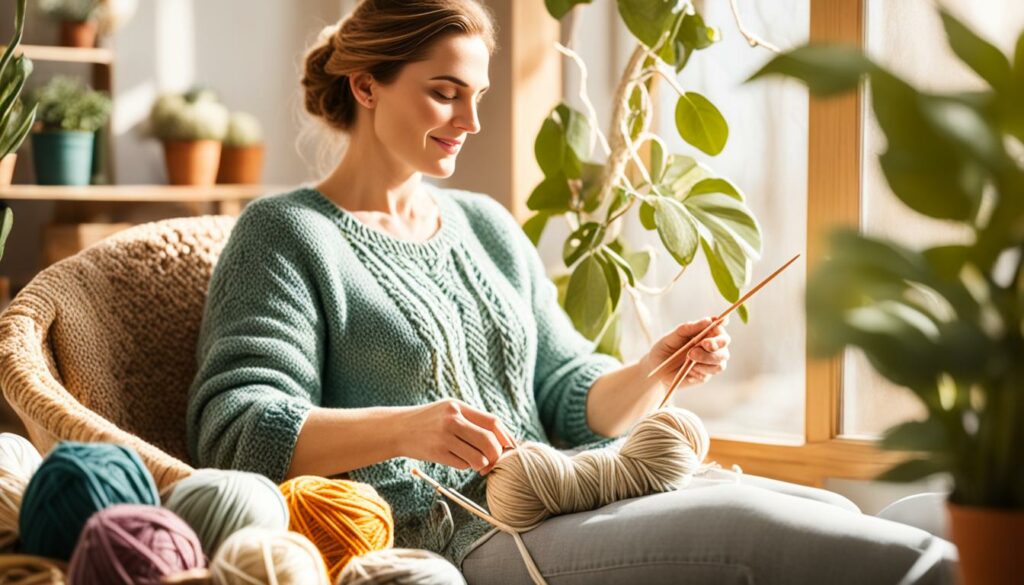
Yarn Crafts and Artistic Expression
| Benefits | Examples |
|---|---|
| Unleashing Creativity | Designing intricate lace patterns |
| Personal Expression | Creating custom color combinations |
| Therapeutic Outlet | Using repetitive stitches for relaxation |
| Empowerment | Developing individual style and techniques |
Yarn Stores as a Source of Inspiration
When it comes to finding new yarn projects or seeking inspiration for your next crafting endeavor, yarn stores are an absolute treasure trove. These havens of creativity offer a wide array of yarn options, patterns, and samples that can spark your imagination and ignite new ideas. Whether you are a seasoned yarn enthusiast or just starting your crafting journey, stepping into a yarn shop can be a rejuvenating experience that opens up a world of possibilities.
One of the greatest advantages of yarn stores is the opportunity to explore a vast selection of yarns from different brands and materials. You can touch and feel the textures, examine the colors, and assess the thickness to find the perfect yarn for your project. This hands-on experience allows you to truly connect with the materials and envision how they will come to life in your creations.
Moreover, the diverse range of patterns available in yarn stores can provide endless inspiration for your projects. Whether you are looking for a knitting pattern, a crochet design, or something entirely unique, the selection is sure to impress. From intricate lacework to cozy sweaters, the pattern choices cater to all skill levels and styles. Exploring these patterns can expand your creativity and introduce you to new techniques and stitches.
As you navigate through a yarn shop, don’t hesitate to seek guidance from the knowledgeable and passionate staff members. They are there to help you find the perfect yarn, offer recommendations based on your skill level and preferences, and provide valuable insights into the world of yarn crafts. Their expertise can guide you towards exciting new projects and ensure that your creations turn out just the way you envisioned.
Roaming through the aisles of a yarn store can be an immersive experience, stimulating your imagination and sparking your creative juices. From the vibrant colors lining the walls to the beautiful displays of finished projects, the ambiance of a well-curated yarn shop can inspire you in ways you never thought possible. It’s like stepping into a haven of inspiration, where you can lose yourself in the possibilities and fuel your passion for yarn crafts.
So, the next time you’re in need of a creative boost or searching for your next yarn project, don’t hesitate to visit a local yarn store. Allow yourself to be captivated by the endless options, seek inspiration from the vibrant atmosphere, and embrace the guidance of the passionate staff. With every visit, you’ll find yourself embarking on new creative journeys and discovering the joy of bringing your yarn projects to life.
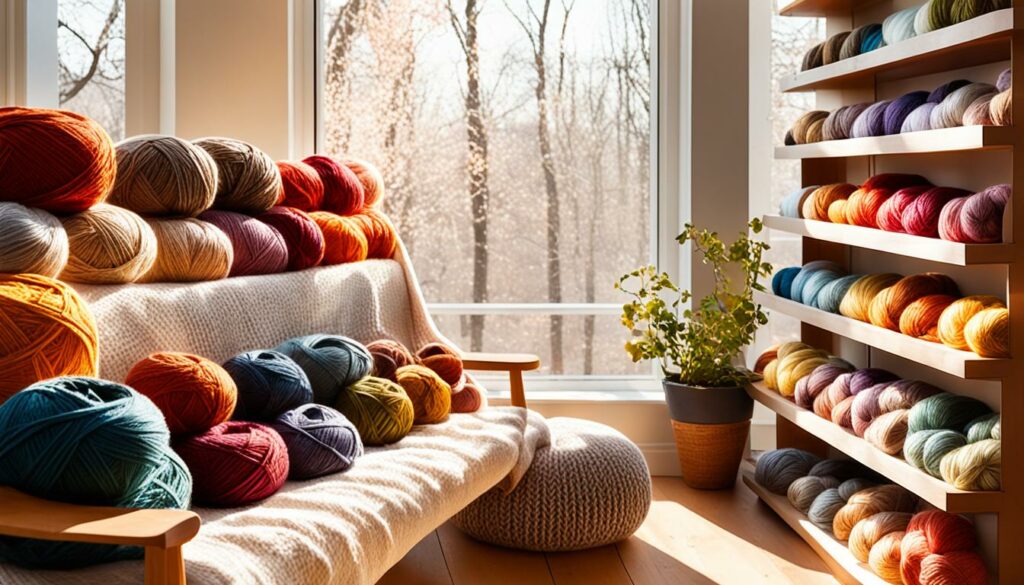
Visiting a yarn store can be a rejuvenating experience, fueling your creativity and inspiring new yarn projects.
Yarn Crafts and Mindfulness
Engaging in yarn crafts, such as knitting and crocheting, can be a gateway to mindfulness and experiencing true presence in the moment. The repetitive motions and focused attention required in these activities naturally lend themselves to quieting the mind and finding a state of mindfulness.
As we pick up the knitting needles or crochet hooks, our minds become attuned to the rhythmic patterns and tactile sensations of the yarn. Each stitch becomes an opportunity to be fully present, anchoring us in the here and now. The gentle movements of our hands guide us into a meditative state, allowing us to tune out distractions and tune into the present moment.
Through knitting or crocheting, we are able to cultivate a profound sense of awareness and connection with our bodies, our breath, and the textures of the yarn. The act of creating something with our own hands becomes a mindful exploration of the creative process, fostering a deep sense of engagement and focus.
Knitting and crocheting can serve as our mindful anchors, grounding us in the present moment and providing a serene space where our thoughts and worries can gently ebb away.
This practice of mindfulness in yarn crafts has far-reaching benefits for our overall well-being. By quieting the mental chatter and immersing ourselves in the simple act of creating stitches, we tap into a wellspring of inner peace and tranquility. Our attention is no longer fragmented; it becomes centered, allowing us to fully savor the beauty and serenity of the present moment.
Mindful Moments: How Yarn Crafts Enhance Our Daily Lives
When we infuse mindfulness into our yarn crafting, we begin to experience a profound shift in our daily lives. We become more attuned to the world around us, fully embracing the sights, sounds, and textures that surround us. The stresses and distractions of the outside world fade into the background as we immerse ourselves in the gentle rhythm of our craft.
Being present in knitting and crochet enables us to find solace and recharge our energies. It offers a respite from the constant demands of our fast-paced lives, allowing us to slow down and savor the simple joys of creating something beautiful with our own hands.
- Feel the gentle touch of the yarn as we delicately guide it through our fingers.
- Witness the masterpiece unfold stitch by stitch, reveling in the transformation from a simple ball of yarn into a work of art.
- Experience the meditative flow of the yarn, each stitch easing us deeper into a state of calm and tranquility.
- Embrace the sense of accomplishment and fulfillment that comes with completing a project, knowing we have poured our heart and soul into its creation.
With each stitch, we cultivate a mindful connection to our inner selves, embracing the beauty of the present moment and finding harmony within. Knitting and crocheting become more than just crafts; they become powerful tools for self-discovery, self-care, and emotional well-being.
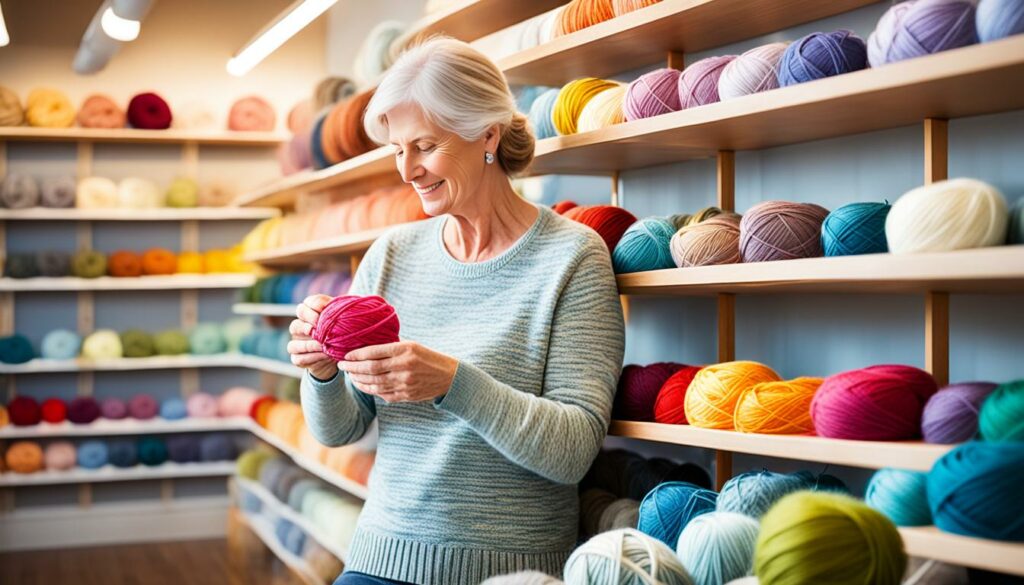
Mindful Tips for Your Yarn Craft Practice
Here are some tips for infusing mindfulness into your yarn craft practice:
- Set aside dedicated time for your yarn crafting, creating a sacred space where you can immerse yourself fully in the experience.
- Treat each stitch as a mindful breath, allowing yourself to be fully present and engaged in the process.
- Focus on the sensation of the yarn moving through your fingers and the steady rhythm of your movements.
- Embrace imperfections and mistakes, seeing them as opportunities for growth and learning.
- Take breaks during your crafting to pause, breathe, and appreciate the progress you’ve made.
The journey of mindfulness through yarn crafts is a deeply personal one. As we create with intention, we weave a tapestry of mindfulness and inner peace, carrying the essence of our craft into every aspect of our lives.
Yarn Store Testimonials: Personal Stories of Healing
In the world of yarn crafts, personal stories of healing and transformation are not uncommon. These heartfelt testimonials from customers who have engaged in yarn crafts and visited yarn stores underscore the incredible impact these activities can have on mental health and overall well-being. Through the nurturing environment of a yarn shop and the therapeutic nature of yarn crafts, individuals have found solace, comfort, and a profound sense of community.
“Engaging in knitting and crochet has truly been a transformative experience for me. When I lost my job and was struggling with anxiety and uncertainty, knitting became my saving grace. The rhythmic motion of the needles and the softness of the yarn brought me a sense of calm and stability. I found comfort in the supportive community at my local yarn store, where I met fellow crafters who understood and uplifted me. Yarn crafts have not only healed my spirit but have also connected me to others in ways I never imagined possible.” – Sarah, a yarn shop customer
“I never expected knitting to become such an integral part of my self-care routine. As a busy working mom, I often felt overwhelmed and stretched thin. However, when I picked up my knitting needles, I found respite from the chaos. Knitting allowed me to slow down, focus on the present moment, and reconnect with myself. The yarn store became my sanctuary, where I could escape the demands of daily life and immerse myself in creativity. Through yarn crafts, I discovered a beautiful form of self-expression and learned to prioritize my own well-being.” – Emily, a yarn shop customer
The personal stories shared by individuals like Sarah and Emily exemplify the power of yarn crafts and the sense of healing they can bring. These stories serve as a testament to the therapeutic benefits of yarn crafts and the supportive environment that yarn shops offer. They inspire others to explore the world of yarn crafts and discover the emotional transformation that can arise from engaging in these creative endeavors.
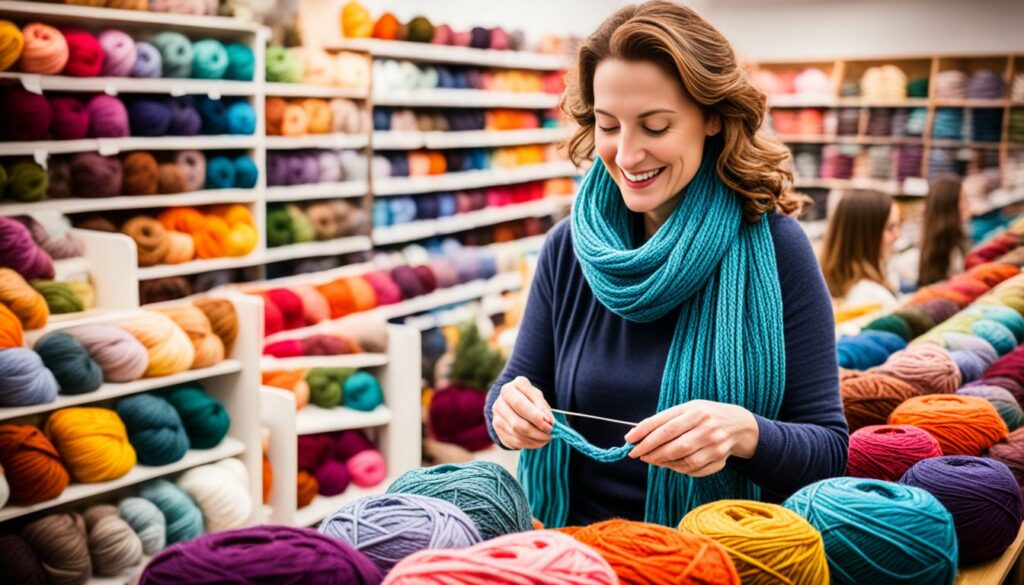
Seeing the smiles on the faces of customers like Sarah and Emily is a testament to the profound impact that yarn stores can have on individuals. Through the art of yarn crafts, people find a sense of purpose, belonging, and personal growth. The combination of a welcoming and supporting community, the therapeutic nature of yarn crafts, and the tranquil atmosphere of a yarn shop creates a space where healing can truly flourish.
Conclusion
In conclusion, yarn stores have proven themselves to be more than just retail establishments. They have the potential to become true healing spaces for the mind and soul. The therapeutic benefits of engaging in yarn crafts, such as knitting and crocheting, cannot be understated. These activities offer an avenue for emotional healing, stress reduction, and overall well-being.
Additionally, the supportive community found in yarn stores plays a vital role in fostering a sense of belonging and understanding. Through classes, workshops, and social gatherings, individuals can connect with others who share a passion for yarn crafts. This sense of community and support contributes to the healing process and enhances the overall experience.
By immersing oneself in the calming and inspiring environment of a yarn store, individuals can find serenity and solace. Whether it’s exploring new yarn projects or honing existing skills, the world of yarn offers endless possibilities for finding contentment and inner peace. Embrace the therapeutic benefits of yarn crafts and discover the healing power of a yarn store. It’s time to unravel a new path to emotional well-being.
